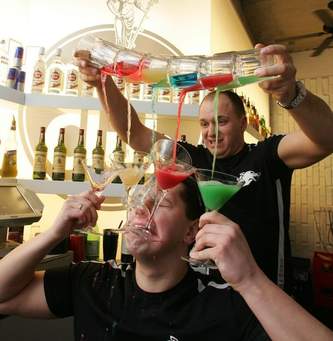
“I know – Let’s put this shit in a can!”
A while back I was tasked with developing campaigns for a caffeinated malt liquor. It shall go nameless. The idea for this heinous concoction could only come from the minds of a large brewery desperate to appeal to young people. Very young people. Probably south of legal drinking age. After all, who else would drink it besides kids who a) want to get really drunk and b) want to stay upright?
“You can sleep when you’re thirty,” was one of our headlines. “Go Long,” was one of our taglines.
Regardless of your opinion of said creative, that was the strategy. Oh, we tried to make the advertising as cool as possible. Designed the hell out of those headlines. Made them look like graffiti or tattoos. Can you say Ed Hardy?
Fact is, we were doomed before we even left the briefing. It was all so messed up. Selling rocket fuel to young douchebags simply sucks. The best we could do was try to tell the truth and be funny. And because the truth is inherently gross the joke was on us.
Some products are like that. Their DNA is so strong in a bad way that its stink cannot be overcome. Taco Bell continues to churn out gut melting travesties of Mexican food and we wonder why, with a few exceptions, the advertising turns our stomach. That the chain is sometimes successful has more to do with marijuana than marketing. Broke and stoned teen-agers gotta eat.
Take this new campaign for something called “Lime-a-Rita.” In the commercial, an art gallery is transformed into a party after two young ladies are served. A statue comes to life and starts boogying. Oy.
Of course this ad is lacking. The product is. Starting with its name. I don’t even know how one begins to tell the truth about this goo. It’s Z-grade tequila (and only a little) mired in green soda pop. I’d rather just pour Cuervo in a glass of Mountain Do. If truth be told, I did a lot of that back in the day. One of many reasons why I don’t drink anymore.
Kids will be kids. They’ll mix shit with shots. The problem is when brands try to do it for you. Red Bull and Vodka is popular but not sold that way. Some drone in sector G of the brewery want to create a caffeinated beer and sell it at 7-11, the agency is going to give him exactly the advertising it deserves.
Honestly, Bud Light’s “Up for Whatever” campaign was ill-advised long before the controversial label.
April 30, 2015
No means no… unless you’re drunk.
This week, Anheuser Busch got taken to the woodshed by numerous publications for a tone-deaf piece of copy that appeared on one of its Bud Light labels:
“The perfect beer for removing ‘no’ from your vocabulary for the night”
Functioning like Tweets these short bursts of copy or “scrolls” were created in support of the brand’s campaign, “Up for Whatever” created by advertising agency, BBDO.
To say I am not a fan of Bud light’s campaign is an understatement. Douche-y by design, this creative idea casts barely drinking age millennials as bar hopping pinballs with zero on their minds other than having A GOOD TIME!
Before going any further, I should add that I once worked on this brand’s advertising. For reasons I won’t fully get into, I loathed the experience. You might think casting bikini-clad babes in Hollywood a highlight in any young man’s career. I’m not denying that it wasn’t fun… at first. But like any binge, it became monotonous and even disgusting. Casting was a charade. For my stupid scripts, any girl would do. Frankly, the lights had been turned off strategically when the light beer category shifted from being a low calorie option to rocket fuel for party animals.
Yet, even in this hopelessly sophomoric category, “Up for Whatever” grates as much as anything out there. Ever. To me, the dumbass “scroll” about “removing the word no from the night’s agenda” is just more proof that being ‘up for whatever’ often leads to bad outcomes. Like rape charges.
That being said, the harpies digging their claws into AB have blinders on. If one is going to hate on Bud Light do so against the whole campaign not just a pimple on its ass. Any fool can see “up for whatever” is a euphemism for removing the word “no.” Why the hell do you think the brand is waving this flag if not to incite 20-somethings into acting like irresponsible teenagers (or irresponsible teenagers to act like irresponsible adults.) Splitting hairs over a specific execution is hypocritical and silly.
University profs weigh in. More context from Newsweek: http://www.newsweek.com/three-advertising-professors-bud-light-fiasco-326830
“Up for Whatever” continues to negatively blow up in social media: http://adage.com/article/cmo-strategy/bud-light-s-label-gafe-lasting-damage/298378/?utm_source=daily_email&utm_medium=newsletter&utm_campaign=adage&ttl=1431049359
The ambivalence in my lead is based on mitigating factors I will get to. First some praise. These new GE commercials are more than TV spots they are truly short films, carefully and wonderfully produced. Every element has been rendered at the highest level of craft. Listen to Beck’s score, for example, how it gently but persuasively pushes our buttons, keying in on what is humanly relevant and even profound. Making us feel the message.
Not to be a shill for GE or its ad agency, BBDO but I could easily rhapsodize about any aspect of these commercials. The casting. The writing. The cinematography. Like them or not, anyone who knows anything about production will recognize the obvious care (and cost) that went into making these commercials. BBDO has long been known for it’s prowess in making exemplary TV campaigns, and these will do nothing to hurt that reputation.
Tonally, both commercials remind me of certain odd, brave feature films that, like them or not, are deserving of praise. Spike Jonze’s award winning film, Her. And the decidedly more flawed but fascinating Luc Besson feature, Lucy. Vaguely unsettling but ultimately heart-wrenching stories of technology, people and the mysteries of life are what propel those films and these commercials.
The comparison is more obvious with Her. Its quirky yet deeply intimate style is, in my view, exactly what the filmmakers of the GE commercials were going for. I chose Lucy because, despite a dubious concept and being silly around the edges, it shoots for the stars and damn near gets there. Lucy is fresh and interesting film. It’s not boring. It tried hard to rise above its genre and B-movie pedigree. Morgan Freeman and Scarlet Johansson certainly helped.
Likewise, these commercials try harder than most. Way more.
That said I am struggling with how similar the GE Scary Ideas film is conceptually to the attached German commercial for Epuron, The Power of Wind, which won countless awards in 2007-08, including top honors in Cannes. You can’t tell me BBDO’s savvy creative leadership were unawares. I’m certain they not only knew about Wind but likely set about emulating it. I’m not sure how I feel about that. Ten years ago I would have called it plagiarism. Now, I’m not sure the term even applies. Is it iteration or a rip off?
Yet, whatever quarrel we may have conceptually or otherwise, we all need to appreciate a client and an agency that tries and unequivocally succeeds at doing something interesting. Period.






 The Happy Soul Industry
The Happy Soul Industry The Last Generation
The Last Generation